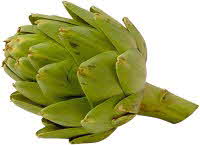FoodReference.com (since 1999)
COOKING TIPS AND HINTS SECTION
Home | Articles | Food Trivia | Today in Food History | Food Timeline | Recipes | COOKING_TIPS | Food Quotes | Who’s Who | Culinary Schools & Tours | Food_Trivia_Quizzes | Food Poems | Free Magazines | Food Festivals and Events
Cooking and Kitchen Tips and Hints, Measurements, Shopping Advice, Serving Ideas, etc.
See Also: Article on Artichokes & Artichoke Facts And Trivia
ARTICHOKES

Artichokes discolor if they come in contact with uncoated aluminum or cast iron. Use a stainless steel knife and nonreactive pans when preparing and cooking them.
Selection - High-quality artichokes are usually compact and heavy for their size. Squeezed, a fresh artichoke will make a squeak. The thickness of each stalk should correspond to the size of the artichoke. Thin stalks signal dehydration, so look for stalks that are firm without 'give.'
When buying artichokes, look for plump, globular ones that are heavy in relation to size. The should be compact, with thick, green, fresh looking scales. Size is not an indication of quality.
AVOID: Artichokes with large brown areas on the scales and with spreading scales - a sign of age, drying and toughening of the edible portion; grayish-black discoloration (bruises), mold growth on the scales and wormy injury.
Peak season for artichokes is in April and May.
Storage - Artichokes remain fairly constant in appearance for weeks, but flavor is adversely affected from the moment they are cut from the stalk. For maximum taste and tenderness, cook as soon as possible. Do not stock up on artichokes. Refrigerate unwashed, in a plastic bag, for up to 1 week.
Preparation - Artichokes should be washed under cold running water. Pull off the lower petals and cut the stems to one inch or less. Cut the top quarter of each artichoke and snip off the sharp tips. Artichokes turn brown very quickly once they are cut. To preserve the green color, one may dip in lemon water.
Artichokes can also stain the hands quite badly so it is recommended that rubber gloves be worn for cleaning and chopping.
Artichokes can be boiled, steamed, microwaved or sautéed. They can be eaten whole or added to other dishes.
Cooked artichokes may be refrigerated for several days in a covered container.
MICROWAVE: cook 6 to 8 minutes or until a petal near the center pulls out easily.
BOILING: Stand artichokes in a large pan with 3 quarts boiling water. Cover and boil gently 20 to 40 minutes according to size, or until the petal near the center pulls out easily.
Small artichokes are good for pickling, stews, casseroles; medium size are good for salads and large size are good for stuffing.
To eat, pull off leaves and eat the fleshy ends attached to the plant. Lift out the cone and cut out the core, which is the fuzzy portion at the center. The heart is a true delicacy and will break easily with a fork. Dip the leaves in lemon juice or try the low-fat dipping sauce in the recipe section.
CDC.gov - 5 a Day
- Try serving and/or stuffing artichokes for a different appetizer.
- Make your vegetable soup unique by adding artichoke hearts.
- Add artichoke hearts to your favorite pasta dish or salad.
- Enjoy a healthy, tart treat-sprinkle lemon, lime and orange juices over steamed leaves.
COOKING TIPS
Please feel free to link to any pages of FoodReference.com from your website.
For permission to use any of this content please E-mail: james@foodreference.com
All contents are copyright © 1990 - 2025 James T. Ehler and www.FoodReference.com unless otherwise noted.
All rights reserved. You may copy and use portions of this website for non-commercial, personal use only.
Any other use of these materials without prior written authorization is not very nice and violates the copyright.
Please take the time to request permission.

